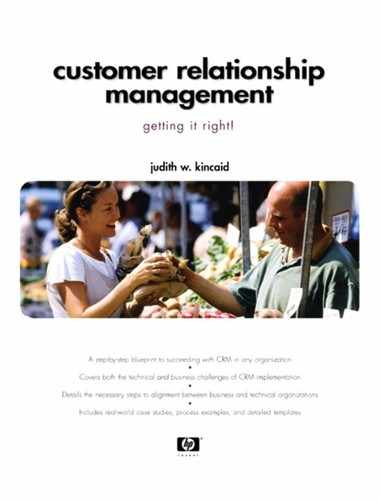6.1. Creating a CRM Culture
Many companies have cultures that don't support CRM. Entrepreneurial-style companies usually promote a high degree of organizational independence (read “separate silos”). Product-centered cultures virtually ignore customers and make decisions based on what they have bought instead of who they are. These cultures create difficulties for building cross-organizational and customer-centered programs like CRM. Changing the whole culture of an organization is far beyond the scope of a CRM program. But we can hope to change some behaviors through training and education and by creating new metrics and rewards.
6.1.1. Change Management
Hey, change happens! We all understand that we have to adapt to change or we'll end up in the same gas tank as the dinosaurs. While examining management challenges for the new millennium, Peter F. Drucker said,
We do not hear much anymore about overcoming resistance to change, which 10 or 15 years ago was one of the most popular topics of management books and management seminars. Everybody has accepted by now that change is unavoidable. But that still implies that change is like death and taxes—it should be postponed as long as possible.
That's just the problem. Many companies are doing quite well to recognize change when it happens; they cannot anticipate and prepare for it. Change can't just be left to happen, because people must make the change, and many are generally resistant, even fearful, of the unknown. Without support and encouragement, the cultural and behavioral changes that will make or break your CRM program success will not happen. Drucker suggests that managing change doesn't guaranteed success. But ignoring the need to manage change guarantees failure. If your organization refuses to pay attention to the basics of change management, you have little chance of delivering a successful CRM program.
For those companies, like yours, who have recognized the need for changing your relationships with your customers, change management is key to changing culture and behavior. But few companies have the in-house expertise to manage change to a successful outcome. Change management is another area in which a consulting organization may play a big role.
When management wants to know how other companies have approached CRM, a consultant can bring external perspective and broad experience. A consultant can help you get the attention of top management because they're being paid so much more than you are. Consultants also bring an outside perspective that can be help keep the program externally focused, skill sets you don't have time to develop for yourself, and processes and tools that support your success. We will learn more about change management in Chapter 14.
6.1.2. Metrics and Rewards
You get the behavior you reward. No exceptions! Years ago, psychologist B.F. Skinner and his rats introduced us to this concept of behaviorism. Whether or not you like some of the implications of Skinner's approach, it is how animals (including humans) learn to change. If you want your employees to adopt new customer-focused goals and consistently deliver excellent customer experiences (the behavior), you have to have a way to recognize the new behavior and reward it when it happens. Here's an example:
Straight commission rewards selling specific products. We want our sales reps to focus on understanding the customer's situation and to offer solutions that solve their problems, whether or not every piece of the solution earns commission. Sales reps aren't in this for the karma; we need to be able to measure this behavior (customer satisfaction with solution) and reward it (some percentage of the total value of the solution).
When you track the customer experience and measure loyalty (along with the normal financial measures, of course) you can use the information to build reward systems that will create an organizational culture that is better prepared for CRM. Measuring individual efforts to improve the customer experience and rewarding it will have a big impact.
Think of the service at a Ritz Carleton Hotel. Any request for anything (even the time of day) is responded to with a smile and the words, “My pleasure.” Employees are trained to respond to guests in this way; their performance is measured and so is the resulting customer experience and loyalty. It may sound hokey, but even though we know it's almost a gimmick, it feels great. Guests report that they do feel welcome and honored and that the employees treat them as if it's a pleasure to assist them. What an incredible difference a small behavior change like this might make for the customers calling your support line!
6.1.3. Sponsorship
We know that unless we have the critical support of the executive sponsor, we have virtually no buffer between our program and the unexpected roadblocks that always occur. We're going to learn about how to find and “manage” a sponsor in Chapter 7. Here, we just want to emphasize how important a sponsor is to leading you past the cultural barriers that you run into. First, you need an executive sponsor who understands and believes in what CRM can do for your company. It's even better if the sponsor is the person who initiated CRM in the company. Second, your sponsor must carry enough clout to influence other parts of the organization through leadership and example.
|
In small companies, the CEO or one of his direct reports may be playing the CRM sponsor role and will actively participate in the program steering committee. In larger organizations, if the sponsor is high enough to have the influence you need, it's unlikely that he or she will actually play any active role in the program. Still, it's essential that you actually have some direct time together, or you really don't have sponsorship.

